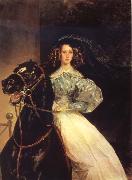
Oil On
Canvas, Real Flavor of Old Masters
|
Karl Briullov
|
|||
|
|
|||
| Russian Neoclassical/Romantic Painter, 1799-1852,was an internationally renowned Russian painter. He is regarded as a key figure in transition from the Russian neoclassicism to romanticism. Born of French parents in Saint Petersburg, Carlo Brulleau (as his name was spelled until 1822) felt drawn to Italy from his early years. Despite his education at the Imperial Academy of Arts (1809?C1821), Briullov never fully embraced the classical style taught by his mentors and promoted by his brother, Alexander Briullov. After distinguishing himself as a promising and imaginative student and finishing his education, he left Russia for Rome where he worked until 1835 as a portraitist and genre painter, though his fame as an artist came when he began doing historical painting. His best-known work, The Last Day of Pompeii (1830?C1833), is a vast composition compared by Pushkin and Gogol to the best works of Rubens and Van Dyck. It created a sensation in Italy and established Briullov as one of the finest European painters of his day. After completing this work, he triumphantly returned to the Russian capital, where he made many friends among the aristocracy and intellectual elite and obtained a high post in the Imperial Academy of Arts. | |||
|
|
|||
|
|
Rider new12/Karl Briullov-873347.jpg Painting ID:: 39495 Visit European Gallery |
mk149 Double portrait of Giovanina and Amazilia Pacini 1832 | |
Height Width |
INS/CM |
||
|
X |
|
||
|
|
|||







